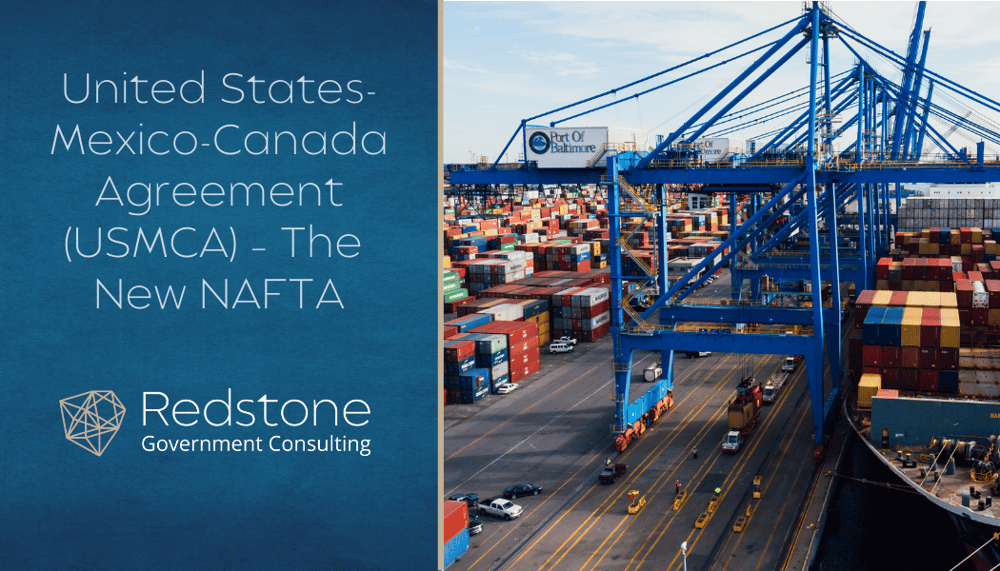Are you Ready for the July 1st Implementation Date?
The new United States-Mexico-Canada Agreement (USMCA) goes into effect on July 1, 2020. Are you ready? When implemented, the agreement should help create more balanced, reciprocal trade that supports high-paying jobs for Americans and grows the North American economy.
The agreement highlights include:
- Creating a more level playing field for American workers, including improved rules of origin for automobiles, trucks, textiles and other products, and disciplines on currency manipulation.
- Benefiting American farmers, ranchers, and agribusinesses by modernizing and strengthening food and agriculture trade in North America.
- Supporting a 21st Century economy through new protections for U.S. intellectual property and ensuring opportunities for trade in U.S. services.
- New chapters covering Digital Trade, Anticorruption, and Good Regulatory Practices, as well as a chapter devoted to ensuring that Small and Medium Sized Enterprises benefit from the Agreement.
Preparing for USMCA: 6 Steps for Importers and Exporters
1. Review Your Old NAFTA Certificates of Origin and your current HTS and Schedule B Classifications
Just because one or more of your products may have qualified under NAFTA does not automatically mean they qualify under USMCA. And vice versa, products that did not qualify for NAFTA may be able to qualify for the USMCA. Review your HTS and Schedule B Classifications and analyze your rules of origin.
2. Determine Who Will Provide the Certificate of Origin
Under USMCA, importers, exporters, or producers are now able to certify that the goods qualify. However, it's usually the exporter or the producer of the goods who has enough information to make that certification.
Also, the USMCA has no official template that must be used. Instead, the Annex 5-A of the USMCA outlines the minimum data requirements that must be included with certification. The NAFTA Certificate of Origin will NOT be allowed to be used.
The required data elements are:
- Importer, Exporter, or Producer Certification of Origin
- Certifier
- Exporter
- Producer
- Importer
- Description and HS Tariff Classification of the Good
- Origin Criteria
- Blanket Period
- Authorized Signature and Date
3. Assess the Impact of the USMCA Changes
Certain parts of the USMCA include more significant changes from NAFTA than others, so not all companies and industries will be impacted the same. If you determine your goods no longer qualify, are there changes in how you source materials for your goods that will help them qualify? And there may be cases that goods did not qualify under NAFTA but may now qualify under USMCA.
Also - keep in mind that USMCA, just like NAFTA, is a voluntary program.
4. Identify Strategies That Lessen the Impact of the Changes
In addition to addressing specific types of products, USMCA includes other new or revised provisions that may make qualifying your goods easier to do. For example, the agreement increases the de minimus amount from 7% to 10% when determining origin. That means that if non-originating parts of a good represent no more than 10% of the total value of the goods, they may now qualify as long as they satisfy all the other terms of the agreement.
5. Update Manuals and Procedures
You will need to maintain a record of where all the goods originate and a detailed description of your sourcing, production and determination process that would allow an auditor to clearly see that the goods qualify.
6. Review Your Contract Terms
Your company has agreements in place with your vendors and customers that outline the duties and responsibilities when doing business with them. Now is the time to review those agreements and make any necessary adjustments to comply with USMCA.
The USMCA Rules of Origin
Section 202 of the USMCA Implementation Act specifies the Rules of Origin used to determine whether a good qualifies as an originating good under the Agreement. There are specific Rules of Origin for the automotive and certain other industries. But in general, under the USMCA a good is originating when:
- The good is wholly obtained or produced entirely in the territory of one or more of the Parties, as defined in Article 4.3 of the Agreement;
- The good is produced entirely in the territory of one or more of the Parties using non-originating materials provided the good satisfies all applicable requirements of product-specific rules of origin;
- The good is produced entirely in the territory of one or more of the Parties exclusively from originating materials; or
- Except for a good provided for in Chapter 61 to 63, HTSUS: the good is produced entirely in the territory of one or more of the Parties, is classified with its materials or satisfies the “unassembled goods” requirement, and meets a regional value content threshold of not less than 60% if the transaction value method is used or not less than 50% if the net cost method is used (not including RVC for autos); and
- The good satisfies all other applicable origin requirements.
Resources:
http://www.cbp.gov



 Carolyn Turner is an Export/Import Compliance Consultant at Redstone Government Consulting, Inc., specializing in international trade regulations, including International Traffic in Arms Regulations (ITAR) and Export Administration Regulations(EAR) on the export side. She provides guidance on import compliance matters such as customs clearance, classification, free trade agreements, country of origin requirements, duty drawback, and supply chain analysis. Carolyn advises contractors on regulatory compliance and develops policies and procedures to support effective international trade operations. Since 2002, Carolyn has held roles including International Research Analyst, International Trade Specialist, and Assistant Director or Research and Training at the Alabama International Trade Center, where she conducted market analyses, and provided training and consulting to small and medium-sized businesses across all industry sectors. She also has experience in freight forwarding working as the NVO coordinator for both imports and exports. And she has also served as an Adjunct Professor at the University of Alabama, developing and teaching online International Business courses.Carolyn is a Licensed U.S. Customs Broker and a NASBITE Certified Global Business Professional. She is proficient in Spanish. Her skills include Incoterms, import and export documentation, ITAR/EAR, free trade agreements, compliance program development, and international finance.She holds a B.S. in Commerce and Business Administration and a Master’s in Management with a Global Business Concentration from the University of Alabama. Carolyn serves on the boards of the Japan America Society of Alabama, Destination Hoover International, and BIO Alabama, and is a member of the Export Alabama Alliance.
Carolyn Turner is an Export/Import Compliance Consultant at Redstone Government Consulting, Inc., specializing in international trade regulations, including International Traffic in Arms Regulations (ITAR) and Export Administration Regulations(EAR) on the export side. She provides guidance on import compliance matters such as customs clearance, classification, free trade agreements, country of origin requirements, duty drawback, and supply chain analysis. Carolyn advises contractors on regulatory compliance and develops policies and procedures to support effective international trade operations. Since 2002, Carolyn has held roles including International Research Analyst, International Trade Specialist, and Assistant Director or Research and Training at the Alabama International Trade Center, where she conducted market analyses, and provided training and consulting to small and medium-sized businesses across all industry sectors. She also has experience in freight forwarding working as the NVO coordinator for both imports and exports. And she has also served as an Adjunct Professor at the University of Alabama, developing and teaching online International Business courses.Carolyn is a Licensed U.S. Customs Broker and a NASBITE Certified Global Business Professional. She is proficient in Spanish. Her skills include Incoterms, import and export documentation, ITAR/EAR, free trade agreements, compliance program development, and international finance.She holds a B.S. in Commerce and Business Administration and a Master’s in Management with a Global Business Concentration from the University of Alabama. Carolyn serves on the boards of the Japan America Society of Alabama, Destination Hoover International, and BIO Alabama, and is a member of the Export Alabama Alliance.